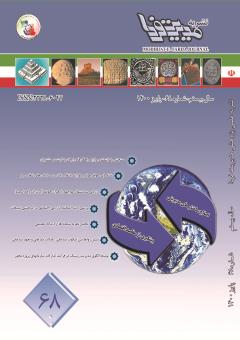بررسی راهکارهای مقابله با کمبود نیروی متخصص امنیت فضای سایبر در کشور
محورهای موضوعی : مدیریت فناوری اطلاعاتمحمد فتحیان 1 , مهدی عبدالحمید 2 , محمدرضا رفیعی 3
1 - استاد، گروه تجارت الکترونیکی، دانشکده مهندسی صنایع، دانشگاه علم وصنعت ایران، تهران، ایران
2 - استادیار، گروه مدیریت و فلسفه علم و فناوری، دانشکده مهندسی پیشرفت، دانشگاه علم و صنعت ایران، تهران، ایران
3 - دانشجوی کارشناسی ارشد مدیریت فناوری اطلاعات، دانشکده مهندسی پیشرفت، دانشگاه علم و صنعت ایران، تهران، ایران
کلید واژه: کمبود متخصص امنیت سایبر, توسعه نیروی کار, روش تحلیل سلسله مراتبی فازی, تحلیل اهمیت- عملکرد,
چکیده مقاله :
نیروی کار متخصص یکی از مهمترین سرمایههای امنیت فناوری اطلاعات به شمار میرود که امروزه بخش خصوصی و دولتی در سرتاسر دنیا در حال رقابت برای جذب این افراد هستند. کشور ما نیز مطابق نظر کارشناسان با کمبود نیروی متخصص امنیت سایبر مواجه است که میتواند موجب بروز آسیبهای مختلف و خطرناکی شود. پژوهش حاضر در تلاش است که برای رویارویی با این مشکل در کشور راهکارهایی ارائه دهد. برای یافتن راهکارها بعد از مطالعه منابع مرتبط با کارشناسان حوزه امنیت سایبر مصاحبه نیمه ساختیافته صورت پذیرفته و نتایج با روش تحلیل مضمون استقرایی تحلیل شد. بدین ترتیب 21 راهکار و 5 راهبرد شناسایی شدند سپس راهبردهای به دست آمده به وسیله روشهای تحلیل سلسله مراتبی فازی و راهکارها به وسیله تحلیل اهمیت-عملکرد اولویتبندی شدند. مطابق نتایج بهدستآمده، راهبردهای حفظ و نگهداری نیرو، ارتقای دورههای آموزشی از اولویت بیشتری نسبت به سایر راهبردها برخوردار هستند. همچنین با توجه به وضعیت فعلی کشور، توجه به طرحهای ترکیبی آموزشی-استخدامی، اجرای طرحهای ارزیابی و استعدادیابی، برگزاری رویدادهای مرتبط با حوزه امنیت سایبر، اجرای طرحهای با مخاطب دانشآموزی، قانونگذاری مناسب و ارتقای سطح الزامات امنیتی از موارد دارای اهمیت بیشتر ارزیابی شده است.
Expert workforce is one of the most important IT security assets that private and public sectors around the world are currently competing for. According to specialists, Iran is also facing the shortage of cyber security experts, which can lead to potentially serious problem. This study presents some solutions for this problem in Iran. In order to identify the solutions, literature was reviewed and semi-structured interviews were conducted through related various experts and specialists. Finally, strategies were prioritized by fuzzy analytic hierarchy process and solutions are investigated by importance-performance analysis. According to the results, specialists believe that workforce maintaining and training improvement are more important than other strategies. Training-recruitment plans, aptitude assessment plans, cyber security events and challenges, schools student targeted plans and improving policies and rules have been considered as more important solutions.
CYBERSECURITY WORKFORCE DEVELOPMENT TOOLKIT How to Build a Strong Cybersecurity Workforce, U.S.D.O.H. Security, Editor. 2016.
Mustaca, S. What is a security expert? 2015; Available from: https://blog.isc2.org/isc2_blog/2015/02/what-is-a-security-expert.html.
Timlin , K. and F. Reeder, Recruiting and retaining cybersecurity ninjas. 2016.
Savola, R.M. Current level of cybersecurity competence and future development: case Finland. in Proceedings of 11th European Conference on Software Architecture: Companion Proceedings. 2017.the
NATIONAL CYBER STRATEGY, T.W. House, Editor. 2018.
Strategies for Building and Growing Strong Cybersecurity Teams (ISC)2 CYBERSECURITY WORKFORCE STUDY, 2019.
Newhouse, W., S. Keith, B. Scribner and G. Witte , National initiative for cybersecurity education (NICE) cybersecurity workforce framework. NIST Special Publication, 2017.
Libicki, M.C., D. Senty, and J. Pollak, Hackers wanted: An examination of the cybersecurity labor market. 2014.
Teoh, C.S. and A.K. Mahmood, Cybersecurity Workforce Development for Digital Economy. The Educational Review, USA, 2018. 2(1): p. 136-146.
Evans, K. and F. Reeder, A human capital crisis in cybersecurity: Technical proficiency matters. 2010.
Crumpler, W. and J.A. Lewis, The Cybersecurity Workforce Gap. 2019: CSIS.
Cybersecurity Professionals Focus on Developing New Skills as Workforce Gap Widens - (ISC)² CYBERSECURITY WORKFORCE STUDY, 2018.
National Cyber Security Strategy 2016-2021. 2016, HM Government London.
French national digital security strategy, in French Republic. 2015.
Cobb, S. Mind this Gap: Criminal hacking and the global cybersecurity skills shortage, a critical analysis. in Virus Bulletin Conference. 2016 (pp. 1-8).
Bashir, M., A. Lambert, B. Guo, N. Memon and T. Halevi , Cybersecurity competitions: The human angle. IEEE Security & Privacy, 2015. 13(5): p. 74-79.
Burley, D.L., J. Eisenberg, and S.E. Goodman, Would cybersecurity professionalization help address the cybersecurity crisis? Communications of the ACM, 2014. 57(2): p. 24-27.
Kshetri, N., Cybersecurity in India: Regulations, governance, institutional capacity and market mechanisms. Asian Research Policy, 2017. 8(1): p. 64-76..
Kelly, D. The economics of cybersecurity. in International Conference on Cyber Warfare and Security. 2017.
Council, N.R., Professionalizing the Nation's Cybersecurity Workforce?: Criteria for Decision-Making. 2013.
Carrese, J., M. Goss, A. Hermann, T. Bartel, K. Greaney, D. Fernandez, Cybersecurity: Labor Market Analysis and Statewide Survey Results .
Creswell, J.W., Educational Research Planning, Conducting, and Evaluating Quantitative and Qualitative Research 4ed. 2012.
Chang, D.-Y., Applications of the extent analysis method on fuzzy AHP. European journal of operational research, 1996. 95(3): p. 649-655.
Gogus, O. and T.O. Boucher, Strong transitivity, rationality and weak monotonicity in fuzzy pairwise comparisons. Fuzzy Sets and Systems, 1998. 94(1): p. 133-144.
Martilla, J.A. and J.C. James, Importance-performance analysis. Journal of marketing,1977. 41(1): p. 77-79.
Oh, H., Revisiting importance–performance analysis. Tourism management, 2001. 22(6): p. 617-627.


